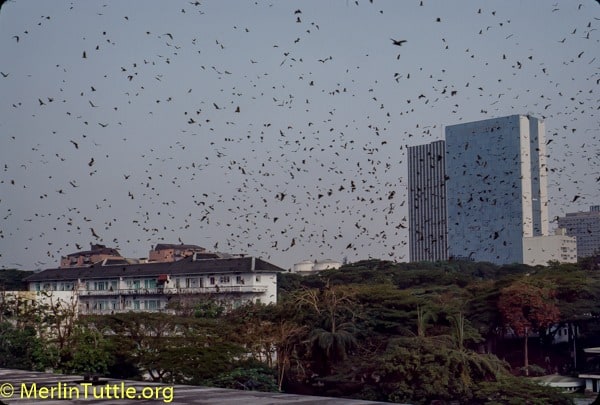Tracking the Impacts of WNS at Wisconsin’s Stonefield Historic Site
“Just like the old days, eh Heather?” Kent softly clicks his tally counter as he sits in his folding chair on the other side of
Lorraine Boissoneault’s story, Can Saving Animals Prevent the Next Deadly Pandemic?, is clearly well intended. However, when it comes to fruit bats and Ebola it is based on outdated speculation that threatens serious harm to a group of mammals that is already in alarming decline. For a summary of current knowledge of bats versus Ebola and other rare, but so-called emerging diseases, and their speculated association with bats, I refer you to my article in the current edition of Issues in Science and Technology, titled “Give Bats a Break.”
Diseases that are millions of years old, but that are just now being discovered due to their rarity, are being referred to as “emerging” as an apparent public relations ploy to make them sound more dangerous. And speculating associations with bats makes them even more scary, since many people already fear bats. This has proven unprecedentedly effective in gaining hundreds of millions of dollars in grants to support so-called virus hunters, who must continue speculating about potentially dire threats from bat diseases to keep their grants flowing.
Bats historically have one of the world’s finest records of living safely with humans, first in caves and thatched huts, then in log cabins.
Even now, millions of bats safely share cities with us, as here in Austin, Texas. Nor is there any credible evidence of epidemics among the millions of humans who eat bats. Finally, neither I nor hundreds of other bat researchers have contracted an “emerging disease” from a bat, despite our very close association. I for example, have spent more than 55 years studying and handling hundreds of species of bats worldwide, often surrounded by millions at a time in caves, and I remain healthy. Like veterinarians, I am vaccinated against rabies, because I am sometimes bitten in self-defense by animals I handle. Yet I have never been protected against any of the diseases about which we are now being warned.
The current campaign to associate bats with scary diseases often gets large numbers of bats killed no matter what else is said, and large colonies are extremely vulnerable.
To put risk in perspective, in the past 20 years, SARS, Hendra, Nipah, Marburg, Ebola and MERS combined have accounted for fewer than 20,000 human deaths worldwide. Clearly, “emerging diseases” account for no more than a minuscule amount of human mortality, most of which is far easier to prevent. Thus the currently popular focus is a huge misappropriation of limited public health resources that harms both bats and humans.
Merlin’s response has been posted in the comment section of the article as well as emailed via the Smithsonian contact page. You are invited to do the same.


Love our content? Support us by sharing it!
“Just like the old days, eh Heather?” Kent softly clicks his tally counter as he sits in his folding chair on the other side of
An important new study, recently published in Science and widely covered by major newspapers like The Guardian, The Washington Post, and The New York Times, has
On March 6, 2024, the Wall Street Journal presented findings from the University of Leeds in their opinion piece, “Why Scientists Love Chasing Bats; The
Response to Misleading Scientific American Bat Story I am responding to the article titled, “A Secret Weapon in Preventing the Next Pandemic: Fruit Bats,” which
2024 © Merlin Tuttle’s Bat Conservation. All rights reserved.
Madelline Mathis has a degree in environmental studies from Rollins College and a passion for wildlife conservation. She is an outstanding nature photographer who has worked extensively with Merlin and other MTBC staff studying and photographing bats in Mozambique, Cuba, Costa Rica, and Texas. Following college graduation, she was employed as an environmental specialist for the Florida Department of Environmental Protection. She subsequently founded the Florida chapter of the International DarkSky Association and currently serves on the board of DarkSky Texas. She also serves on the board of Houston Wilderness and was appointed to the Austin Water Resource Community Planning Task Force.
Michael Lazari Karapetian has over twenty years of investment management experience. He has a degree in business management, is a certified NBA agent, and gained early experience as a money manager for the Bank of America where he established model portfolios for high-net-worth clients. In 2003 he founded Lazari Capital Management, Inc. and Lazari Asset Management, Inc. He is President and CIO of both and manages over a half a billion in assets. In his personal time he champions philanthropic causes. He serves on the board of Moravian College and has a strong affinity for wildlife, both funding and volunteering on behalf of endangered species.